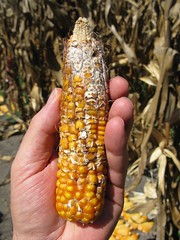Agricultural commodities
are prone to infection from a range of different fungal species. This
is of increasing concern as mycotoxins may be produced as a
by-product of infections.
Biomin, of Austria, says
these toxic metabolites can cause acute and chronic intoxication when
ingested by higher animals, resulting in a negative economic impact
for the livestock industry. Biomin says of special interest are the
Fusarium mycotoxins,
which infect plants in the field but can continue to grow and
contaminate products during storage. temperature and water activity
(available water content to mould in a substrate), are the most
important factors to influence fungal colonization and mycotoxin
production.
| Fusarium ear rot on maize (Photo credit: CIMMYT) |
The trichothecenes (type
A: T-2 toxin and type B: deoxynivalenol) are the largest group of
mycotoxins which contaminate commodities such as corn, wheat, barley
and oats. Trichothecenes, the most abundant source of contamination
in cereal grains today, is due to Fusarium
head blight which is primarily caused by type-B trichothecene
producers (Foroud and Eudes 2009).
A survey in Africa and the
Middle East about the occurrence of mycotoxins in commodities such as
feeds and feed ingredients has been carried out. See the results ...
The Global Miller, published and supported by the GFMT Magazine and the International Milling Directory from Perendale Publishers. And blogs are written by the staff of Grain & Feed Milling Technology daily. Get your copy of 'PPLAPP', our mobile web application which will allow you to view this blog and other useful information while on the move.




No comments:
Post a Comment